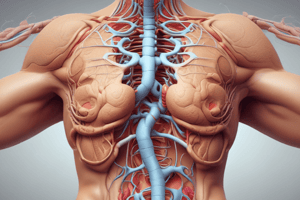Podcast
Questions and Answers
What is the main function of the abdomen?
What is the main function of the abdomen?
To store and protect vital organs.
Which structures provide protection to the abdomen?
Which structures provide protection to the abdomen?
- Abdominal wall (correct)
- Chest cavity (correct)
- Diaphragm (correct)
- Pelvic inlet
The pelvis has distinct borders separating it from the abdomen.
The pelvis has distinct borders separating it from the abdomen.
False (B)
What does the term 'intra-abdominal pressure' refer to?
What does the term 'intra-abdominal pressure' refer to?
The ______ is the central landmark of the abdomen.
The ______ is the central landmark of the abdomen.
Which muscle is considered to be a lateral part of the abdominal wall?
Which muscle is considered to be a lateral part of the abdominal wall?
What planes are used to divide the abdomen into quadrants?
What planes are used to divide the abdomen into quadrants?
The ______ is a fatty layer of superficial fascia in the abdominal wall.
The ______ is a fatty layer of superficial fascia in the abdominal wall.
Match the following abdominal muscles with their respective locations:
Match the following abdominal muscles with their respective locations:
Flashcards are hidden until you start studying
Study Notes
Abdominal Overview
- The abdomen stores and protects vital organs, including the liver, gallbladder, stomach, spleen, and parts of the colon.
- The diaphragm and thoracic cavity shield most of these organs, while the abdominal wall provides protection for the remaining areas.
- The abdomen aids in respiration by altering intra-abdominal pressure, facilitating functions such as urination, defecation, and childbirth.
- A weak abdominal musculature can lead to lumbar lordosis, affecting spinal posture.
Boundaries of the Abdomen
- Upper boundary includes the inferior thoracic aperture, diaphragm, and T12 vertebra along with the 11th and 12th ribs and the costal margin.
- Lower boundary is defined by the pelvic inlet, sacrum, bony rim of the pelvis, and pubic symphysis.
- Absence of a clear boundary between the abdomen and pelvis can result in the spread of infections.
Composition of the Abdominal Wall
- Comprised of bones and muscles that provide structural support.
- Anterior lateral wall includes transversus abdominis, internal oblique, external oblique, and rectus abdominis muscles.
- Posterior wall consists of quadratus lumborum, psoas major, and iliacus muscles.
- Key landmarks visible at the anterior view include the umbilicus as the central point, and linea alba marking a tendinous line from the xiphoid process to the pubic symphysis.
Abdominal Regions
- The abdomen is divided into four quadrants by the median plane and transumbilical plane (at the L3-L4 IV disc).
- Nine regions established by the midclavicular plane, subcostal plane, transpyloric plane, transtubercular plane, and interspinous plane.
- Each horizontal line contributes to the organization of the abdominal cavity, facilitating medical assessment and diagnosis.
Muscles of the Abdominal Wall
- Superficial to deep layer structure consists of skin, superficial fascia, deep fascia, and muscles.
- Muscles involved include:
- Superior: Diaphragm
- Anterior: Rectus abdominis
- Lateral: External oblique, internal oblique, transversus abdominis
- Posterior: Quadratus lumborum, iliacus, psoas major
Superficial Fascia
- Comprises Camper's fascia, a superficial fatty layer covering the abdominal wall.
- Important for the presence of blood vessels (Thoraco-epigastric vein) that drain into the axillary vein.
General Notes
- Strong understanding of abdominal anatomy is essential for clinical practice and diagnosis.
- Awareness of the relationship between the abdominal wall muscles and the structural integrity of the abdomen is critical.
Studying That Suits You
Use AI to generate personalized quizzes and flashcards to suit your learning preferences.



